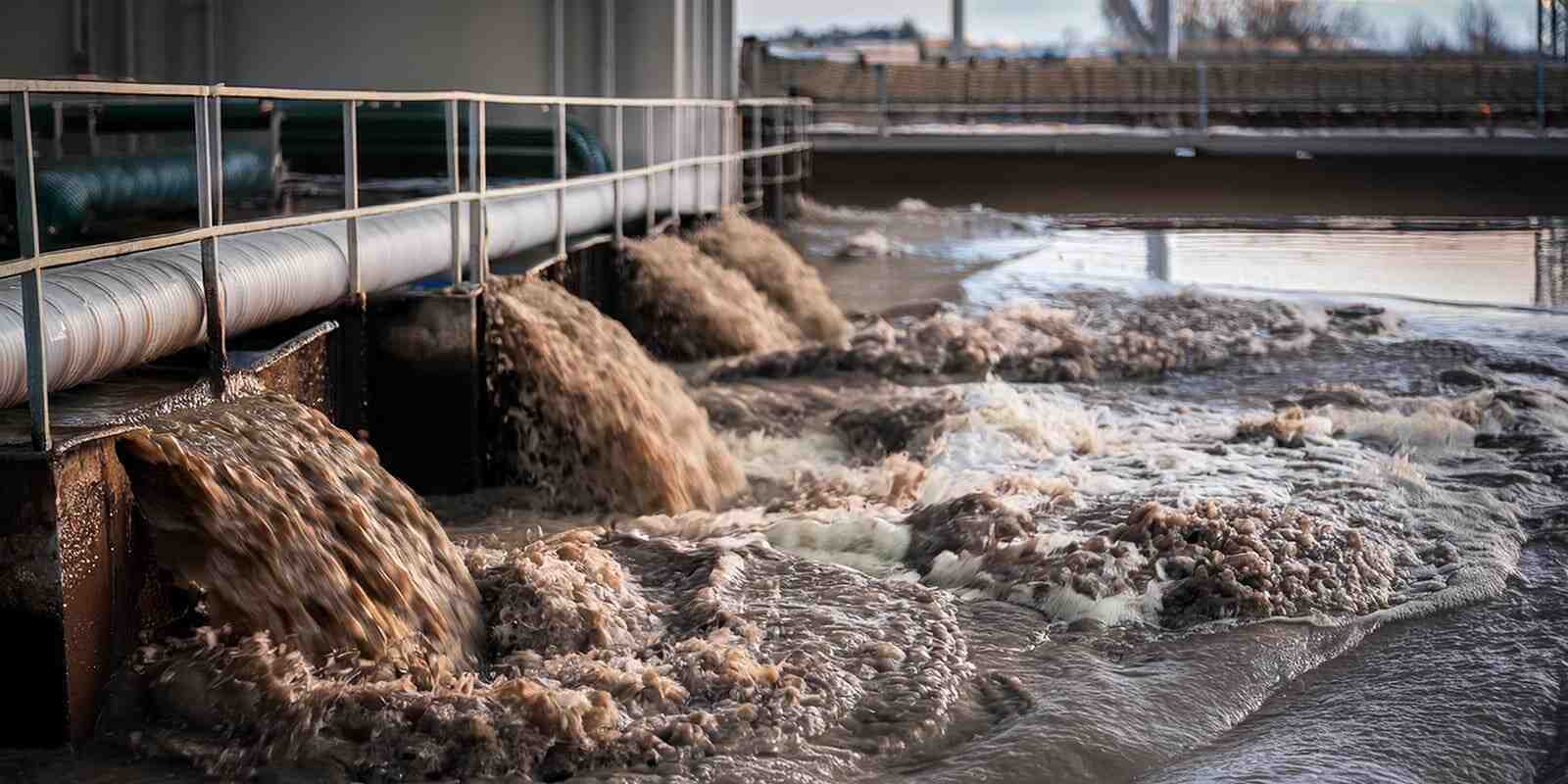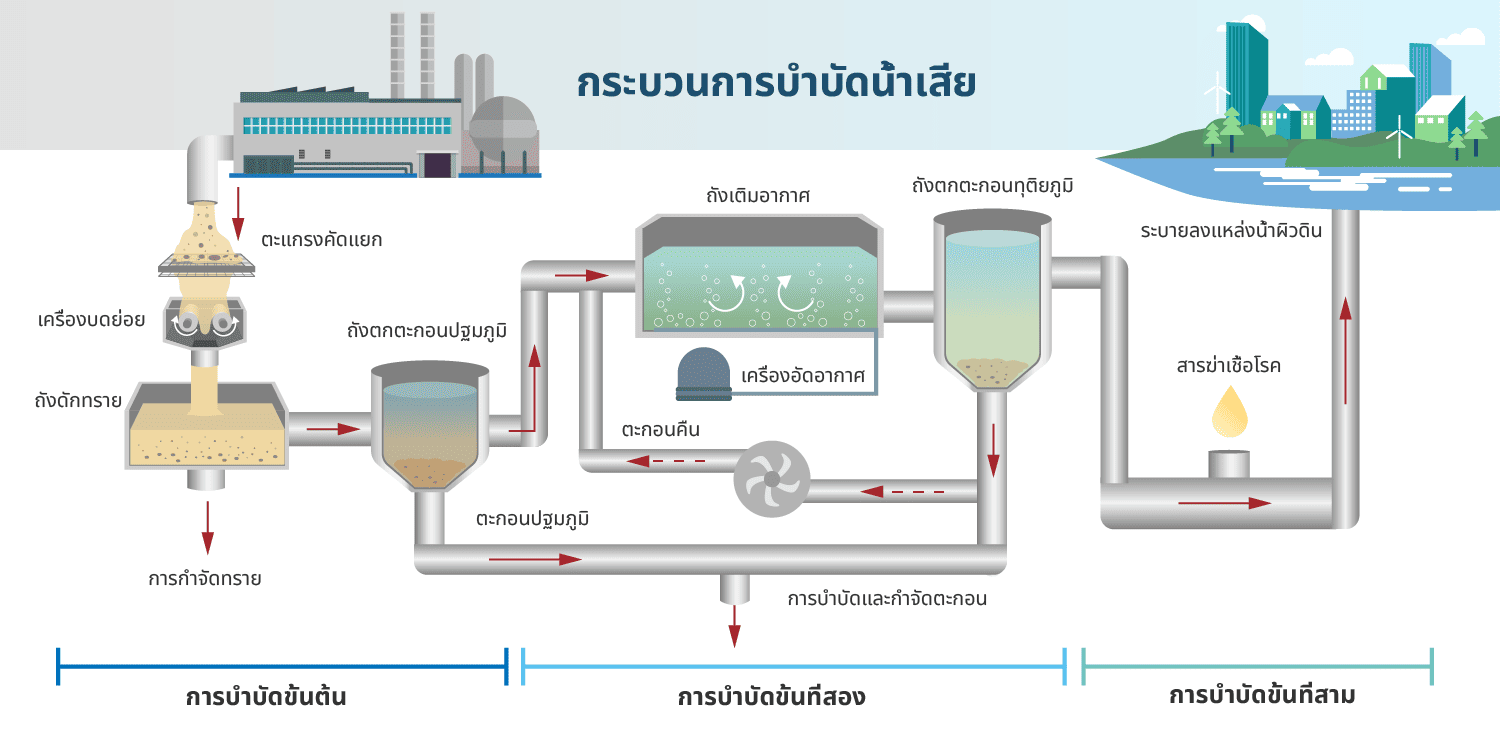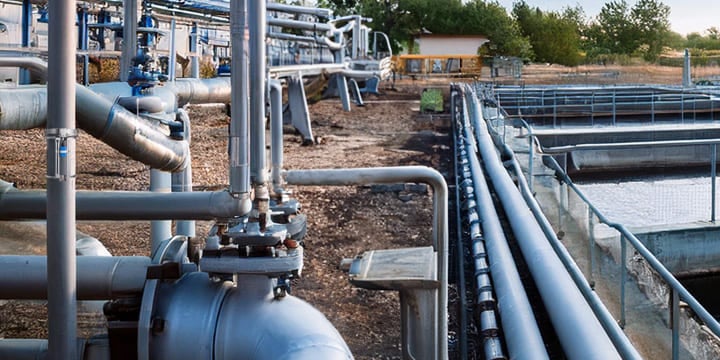การบำบัดน้ำเสียคืออะไร
การบำบัดน้ำเสียมีวัตถุประสงค์เพื่อกำจัดสารปนเปื้อนออกจากน้ำที่ใช้ในครัวเรือน อุตสาหกรรม และธุรกิจ เพื่อให้น้ำปลอดภัยต่อการปล่อยคืนสู่สิ่งแวดล้อมหรือการนำกลับมาใช้ใหม่ กระบวนการนี้รวมถึงการกำจัดของแข็งแขวนลอย ลดสารอินทรีย์และมลพิษ และกำจัดแบคทีเรียและไวรัสที่เป็นอันตราย
กระบวนการบำบัดเบื้องต้นสามารถกำจัดของแข็งแขวนลอยได้ประมาณ 60% ในขณะที่กระบวนการบำบัดขั้นที่สองสามารถกำจัดได้มากกว่า 90%
[1]
ทำไมการบำบัดน้ำเสียจึงสำคัญต่อการพัฒนาที่ยั่งยืนทั่วโลก
การขยายการบำบัดน้ำเสียมีความสำคัญอย่างยิ่งต่อการบรรลุเป้าหมายการพัฒนาที่ยั่งยืน (SDG) ข้อ 6.3 ซึ่งมุ่งเน้นการปรับปรุงคุณภาพน้ำโดยลดมลพิษและลดสัดส่วนของน้ำเสียที่ไม่ได้รับการบำบัดลงครึ่งหนึ่ง ภูมิภาคต่าง ๆ ทั่วโลก โดยเฉพาะพื้นที่ที่มีมลพิษสูง จำเป็นต้องมีการขยายระบบบำบัดน้ำเสียอย่างมีนัยสำคัญ
ตัวอย่างเช่น ประเทศอย่างจีน สหรัฐอเมริกา และอินเดีย เป็นผู้นำในการขยายระบบบำบัดน้ำเสียที่จำเป็นภายในปี 2030 การขยายนี้ไม่เพียงแต่เพิ่มขีดความสามารถของระบบบำบัด แต่ยังรวมถึงการปรับปรุงประสิทธิภาพในการกำจัดมลพิษ เช่น ความต้องการออกซิเจนทางชีวภาพ (BOD) และแบคทีเรียฟีคัลโคลิฟอร์ม (FC) เพื่อยกระดับคุณภาพน้ำผิวดินให้ดียิ่งขึ้น
[2]
ความท้าทายในการบำบัดน้ำเสีย

หนึ่งในความท้าทายสำคัญในการบำบัดน้ำเสียคือการจัดการกับสารปนเปื้อนใหม่ ๆ เช่น ยาและไมโครพลาสติก ซึ่งส่งผลกระทบต่อสุขภาพมนุษย์และสิ่งแวดล้อม สารปนเปื้อนเหล่านี้มักยังไม่ได้รับการศึกษาอย่างครบถ้วน ทำให้ยากต่อการบูรณาการเข้าสู่กระบวนการจัดการและบำบัดน้ำอย่างมีประสิทธิภาพ
[3]
น้ำเสียรีไซเคิล: ทางแก้ไขที่ยั่งยืน
การรีไซเคิลน้ำเสียกำลังกลายเป็นส่วนสำคัญที่เพิ่มขึ้นในด้านการจัดการทรัพยากรน้ำ วิธีการนี้เกี่ยวข้องกับการบำบัดน้ำเสียในเขตเมืองให้มีคุณภาพสูงขึ้น และนำกลับมาใช้ใหม่ทั้งในวัตถุประสงค์ที่ดื่มได้และที่ไม่ดื่มได้
การปฏิบัตินี้มีความสำคัญอย่างยิ่งในพื้นที่ที่เผชิญกับการขาดแคลนน้ำ และได้รับการสนับสนุนจากความก้าวหน้าด้านเทคโนโลยี การตรวจสอบที่เชื่อถือได้ และการยอมรับจากสาธารณะ น้ำเสียรีไซเคิลสามารถนำกลับคืนสู่สิ่งแวดล้อมหรือนำไปใช้ในระบบน้ำประปาโดยตรง ช่วยเพิ่มความหลากหลายของแหล่งน้ำและเสริมความมั่นคงทางน้ำ โดยเฉพาะในช่วงที่เกิดภัยแล้ง
แนวโน้มอุตสาหกรรมและทิศทางในอนาคต
อุตสาหกรรมการบำบัดน้ำเสียกำลังพัฒนาไปพร้อมกับเทคโนโลยีใหม่ ๆ และแนวทางการจัดการที่ตอบสนองความต้องการน้ำสะอาดที่เพิ่มขึ้น นวัตกรรมในกระบวนการบำบัด กรอบการกำกับดูแล และความตระหนักของสาธารณะกำลังกำหนดอนาคตของการจัดการน้ำเสีย
ความสนใจในปัจจุบันกำลังมุ่งไปสู่การใช้วิธีการที่ยั่งยืน มีประสิทธิภาพ และคุ้มค่ามากขึ้น ไม่เพียงแค่การบำบัดน้ำเสีย แต่ยังรวมถึงการรีไซเคิลและนำกลับมาใช้ใหม่ ซึ่งสอดคล้องกับความพยายามทั่วโลกในการสร้างอนาคตด้านน้ำที่ยั่งยืนและมั่นคงยิ่งขึ้น
การบำบัดน้ำเสียทำงานอย่างไร
โรงงานอุตสาหกรรม เช่น โรงกลั่นน้ำมัน โรงงานเคมี และโรงงานปิโตรเคมี มักผลิตน้ำเสียที่มีความเข้มข้นสูงของสารอินทรีย์ (เช่น น้ำมันและไขมัน) สารมลพิษที่เป็นพิษ (เช่น โลหะหนักและสารประกอบอินทรีย์ระเหยง่าย) และสารอาหาร (เช่น แอมโมเนีย) แม้ว่าน้ำเสียอุตสาหกรรมบางส่วนสามารถบำบัดได้ในโรงบำบัดน้ำเสียเทศบาล แต่กระบวนการอุตสาหกรรมส่วนใหญ่มีโรงบำบัดเฉพาะทางของตนเอง เพื่อให้มั่นใจว่าน้ำเสียที่ผ่านการบำบัดมีความเข้มข้นของมลพิษที่เป็นไปตามมาตรฐานการกำกับดูแลสำหรับการปล่อยลงในระบบระบายน้ำหรือแหล่งน้ำธรรมชาติ

การบำบัดเบื้องต้น (Pretreatment)
นี่คือขั้นตอนแรกของการบำบัดน้ำเสีย ซึ่งมักดำเนินการในทุกขั้นตอนของกระบวนการ จุดมุ่งหมายหลักของการบำบัดเบื้องต้นคือการกำจัดสารอนุภาคขนาดใหญ่ ของแข็ง และน้ำมันหรือไขมันออกจากน้ำเสีย เพื่อลดความเสียหายที่อาจเกิดขึ้นกับกระบวนการบำบัดในขั้นตอนถัดไป
การบำบัดขั้นที่สอง (Physical Treatment)
นี่คือขั้นตอนแรกของการบำบัดน้ำเสีย ซึ่งมักดำเนินการในทุกขั้นตอนของกระบวนการ จุดมุ่งหมายหลักของการบำบัดเบื้องต้นคือการกำจัดสารอนุภาคขนาดใหญ่ ของแข็ง และน้ำมันหรือไขมันออกจากน้ำเสีย เพื่อลดความเสียหายที่อาจเกิดขึ้นกับกระบวนการบำบัดในขั้นตอนถัดไป
การบำบัดขั้นที่สอง (Biological Treatment)
วิธีการบำบัดทางชีวภาพประกอบด้วย:
ตัวกรองไหลผ่าน (Trickling Filters): น้ำเสียถูกส่งผ่านชั้นไบโอฟิล์มเพื่อย่อยสลายสารอินทรีย์
การเติมอากาศ (Aeration): การเติมออกซิเจนลงในน้ำ เพื่อช่วยการย่อยสลายสารอินทรีย์ด้วยแบคทีเรียและเชื้อราแบบใช้ออกซิเจน
การฆ่าเชื้อ (Disinfection): การใช้คลอรีน โอโซน หรือแสงอัลตราไวโอเลตในการกำจัดจุลินทรีย์ที่เป็นอันตราย
ขั้นตอนนี้มีความสำคัญต่อการย่อยสลายสารอินทรีย์ในน้ำเสีย ช่วยลดมลพิษและปรับปรุงคุณภาพน้ำให้เหมาะสำหรับการบำบัดขั้นถัดไปหรือการปล่อยกลับคืนสู่ธรรมชาติ
การบำบัดขั้นที่สาม (Chemical Treatment)
ขั้นตอนนี้เป็นการบำบัดเพิ่มเติมด้วยวิธีทางกายภาพหรือเคมีที่มีความซับซ้อน ประกอบด้วยการใช้เทคนิคต่าง ๆ เช่น:
การกรองขั้นสูง (Advanced Filtration)
การกรองด้วยทราย (Sand Filters)
การใช้ถ่านกัมมันต์ (Activated Carbon)
การตกตะกอนทางเคมี (Chemical Coagulation)
การออกซิเดชัน (Oxidation)
การใช้สาหร่ายขนาดเล็ก (Microalgae) เพื่อฟื้นฟูสิ่งแวดล้อม (Bioremediation)
ขั้นตอนนี้มุ่งเน้นการกำจัดของแข็งแขวนลอย สารอินทรีย์ หรือมลพิษที่ตกค้าง เพื่อปรับปรุงคุณภาพน้ำให้อยู่ในระดับที่เหมาะสมสำหรับการใช้งานหรือการปล่อยคืนสู่ธรรมชาติอย่างปลอดภัย
[4]
การประยุกต์ใช้เครื่องวัดการไหลในระบบบำบัดน้ำเสีย - การตรวจสอบปริมาณน้ำเข้าและน้ำออก
ในกระบวนการบำบัดน้ำเสีย เครื่องวัดการไหลถูกนำมาใช้เพื่อตรวจสอบปริมาณน้ำที่ใช้ในกระบวนการบำบัด ซึ่งช่วยควบคุมต้นทุนให้มีประสิทธิภาพมากขึ้น น้ำที่ไหลเข้ามักประกอบด้วยน้ำสะอาดหรือสารเคมีที่จำเป็นต้องควบคุมผ่านแผงควบคุม เครื่องวัดการไหลที่มีสัญญาณอิเล็กทรอนิกส์สามารถช่วยเพิ่มประสิทธิภาพในการตรวจสอบปริมาณน้ำเข้าได้อย่างมาก

กรณีศึกษา: ผู้ผลิตพลาสติกรายใหญ่ในตลาด
สถานการณ์:
บ่อระบายน้ำเสียของโรงงานเคยใช้เครื่องวัดการไหลแบบพายหมุนชนิดแทรกเข้าไปในท่อ อย่างไรก็ตาม เนื่องจากสิ่งสกปรกภายในท่อน้ำเสียและการสะสมของตะกรันเมื่อเวลาผ่านไป ใบพัดของเครื่องวัดการไหลแบบพายหมุนจึงเกิดความเสียหาย
วิธีแก้ปัญหา:
LORRIC FU-TX310 Clamp-On Ultrasonic Flow Meter
เราได้แนะนำเครื่องวัดการไหลแบบอัลตราโซนิกชนิดหนีบติดท่อรุ่น FU-TX310 ให้กับลูกค้า หลักการวัดแบบไม่รุกล้ำช่วยให้สามารถติดตั้งได้โดยไม่ต้องหยุดการผลิต ไม่ต้องตัดท่อ ไม่มีการรั่วซึม และไม่มีการอุดตัน โพรบวัดถูกติดตั้งด้านนอกของท่อ ช่วยให้การบำรุงรักษาและการถอดออกทำได้ง่าย และไม่ถูกกระทบจากการสะสมของตะกรัน ลดค่าใช้จ่ายในการบำรุงรักษาของลูกค้าได้อย่างมีประสิทธิภาพ